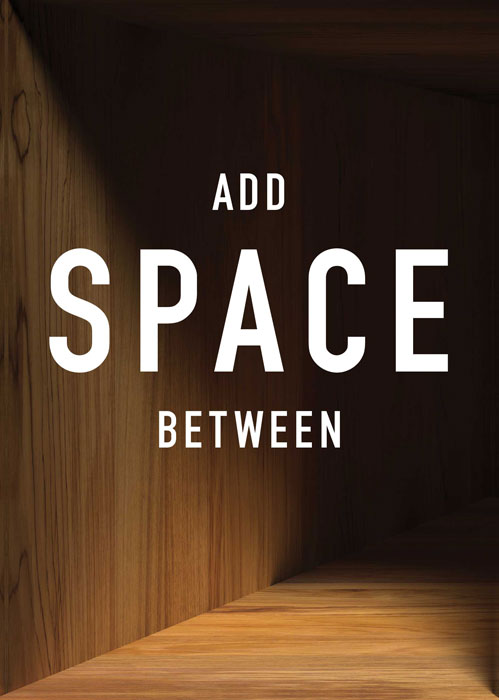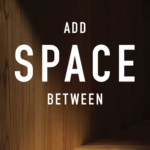Exhibition
in Zürich / Switzerland
- Flyer: “Sophie Dupont, Karin Kurzmeyer, Sofie Thorsen, Theis Wendt – Add Space Between”, 2016, Petra Gut Contemporary, Zurich
The current exhibition presents three female artists and a male artist, all of whom deal with “space” in their particular way. They have in common that they explore possibilities to expand their art work into the third dimension and thus achieve additional consideration within the space.
Sophie Dupont embraces space with her body and performing gestures. Sofie Thorsen’s paintings do not end at the edge of the canvas but continue on the wall. Karin Kurzmeyer forces the audience to move around a given path by deliberately placing her sculptures in the art space. Theis Wendt’s works are not simply reflections – they appear to turn the space surrounding us inside out.
“We Always Carry Our Body” is the most recent work of the Danish performance artist Sophie Dupont (*1975). In this work, Dupont carries body parts made of brass on a stand above the head. The stand, comparable to a skeleton, holds the hanging parts together like a Mobile/puzzle. Her body is covered by a skin-tight black-pink costume, likewise depicting outlines of her internal organs and body parts.
Thus, the body is exposed twice, even three times; as actual body and as an image of the experience of our body that we create in our mind. The stand on the head appears like a trophy and at the same time like a crucifix that we carry with us throughout our life. The audience is requested to randomly place each individual body part on a canvas on the ground. Once all parts are placed on the canvas, Sophie Dupont frees herself from the scaffold and walks over each individual “body part” lying on the canvas. The scaffold and the two pictures showing the prints of the body parts will remain after the performance as pieces of art.
Performance is only one form of media the former dancer tackles. In addition, Sophie Dupont works with photography and sculptures.
The installations of the artist Sofie Thorsen (*1971, Austria), living in Vienna, refer to questions of space, architecture and perception. Usually, her work is guided by a special interest in a certain object or circumstance. Using this as a starting point the artist develops her pictures and installations. At the moment, Thorsen’s work focuses on lines, surfaces and the exhibition wall. The fine lines of her pictures are created by oscillating a pigment dusted chalk line.
Other central topics are photography and paper as “sculptural materials”. As soon as a sheet paper is elevated, it gains a three-dimensional effect. When cut into a form other than a normal square, it becomes a complex, fragile sculpture. This three-dimensional image and the blurred, intensive pigment lines make up the centre of her work and are testament to the fragile qualities of image and space that surround us.
The artists, Theis Wendt, (*1981, DK) living in Copenhagen, in his artistic activity is concerned with the way modern communication technology changes the representation of images and the human perception of the world. He plays around with surfaces and wants to irritate the viewer.
In the series “Rift” he works with digital prints which at first sight appear like passages through a wall, but at the end of the day are pictures and also presented as such. Wendt’s series “Rift” does not show anything unfamiliar, but the familiar and trusted is presented from a completely new perspective. Instead of simply looking out of a window, one simultaneously looks onto reflections of the glass. The latter appear to turn the space surrounding us inside out.
Equally, in the series “Sunk” common perceptions are broken up. This picture series consists of aluminium castings and polystyrene sheets. Polystyrene, the light-weight and insulating material is turned into something cold and heavy. It is no longer hidden as building material. The transformed surfaces reveal their own world of images: For instance, they remind of scarce landscapes – rejecting and foreign and yet attractive.
Karin Kurzmeyer (*1987 in Lucerne, CH) likes the sense of immediacy of clay which she forms into sculptures. “The handling of the clay is like finger exercise,” states the artist living in Zurich. “I well and truly knead and massage the material”. The sculptures appear grown. Hand and finger marks are visible and turn the brittle material into something sensual. The artist is fascinated by clay as each type of clay possesses specific characteristics and the material is “obstinate”. When working the clay, Kurzmeyer transfers her knowledge of the body to the object.
Drying the objects can take up to four months, afterwards they are fired. The clay gains new characteristics through the firing process. Colour and density change. Kurzmeyer uses different types of clay and different firing stages which produce varying shades of colour. The positioning of the large sculptures in the art space is an important part of her work. The objects develop their full creative potential only through the varying perspectives of viewing.
Gallery hours Wed-Fri 11 am – 6:30 pm, Sat 10 am – 4 pm
Die aktuelle Ausstellung präsentiert drei Künstlerinnen und einen Künstler, die sich je durch eine ganz eigene Art mit “Raum” auseinandersetzen. Allen gemeinsam ist, dass sie Möglichkeiten ausloten, indem sie ihre Kunstwerke in die dritte Dimension ausdehnen und so gleichsam im Raum weiterdenken.
Sophie Dupont vereinnahmt durch ihren Körper und die performative Geste den realen Raum. Sofie Thorsens Malerei endet nicht an der Leinwandgrenze, sondern setzt sich auf der Wand fort. Karin Kurzmeyer zwingt das Publikum durch die Platzierung ihrer Skulpturen, sich auf einem von ihr vorgegebenen Parcours durch den Raum zu bewegen. Theis Wendts Arbeiten sind nicht nur Reflexionen – sie scheinen den uns umgebenden Raum von innen nach außen zu kehren.
“We Always Carry Our Body” ist die jüngste Arbeit der dänischen Performance-Künstlerin Sophie Dupont (*1975). In dieser Arbeit trägt Dupont Körperteile aus Messing auf einem Ständer über dem Kopf. Der Ständer, vergleichbar mit einem Skelett, hält die Teile zusammen, die wie ein Mobile/Puzzle daran hängen. Am Körper trägt sie ein hautenges schwarz-rosa Kostüm auf dem ebenfalls Umrisse ihrer inneren Organe und Körperteile zu sehen sind.
Der Körper wird so zweimal, ja dreimal präsentiert; als realer Körper und als Abbild unserer Erfahrungen, die wir im Geist mit unserem Körper machen. Der Ständer auf dem Kopf erscheint wie eine Trophäe und zugleich als Kreuz, das wir während unseres Lebens mit uns zu tragen haben. Das Publikum ist aufgefordert jedes einzelne Körperteil beliebig auf eine auf dem Boden liegende Leinwand zu platzieren. Wenn alle Teile auf der Leinwand liegen, befreit sich Sophie Dupont vom Gestänge und geht über jeden einzelnen auf der Leinwand liegenden “Körperteil”. Das Gestänge und die beiden Bilder, die die Abdrücke der Körperteile zeigen, bleiben nach der Performance als Arbeiten zurück. Performances sind nur eines der Medien, mit der sich die ehemalige Tänzerin auseinandersetzt. Daneben arbeitet Sophie Dupont auch mit Fotografien und Skulpturen.
Die Installationen der in Wien lebenden Künstlerin Sofie Thorsen (*1971, A) beziehen sich auf Fragen zu Raum, Architektur und Wahrnehmung. Meist liegt den Arbeiten ein spezielles Interesse an einem bestimmten Objekt oder einer Situation zu Grunde. Ausgehend davon entwickelt die Künstlerin ihre Bilder und Installationen. Momentan fokussiert sich Thorsen in ihren Arbeiten auf die Linie, die Oberfläche und die Ausstellungswand. Die feinen Linien ihrer Bilder bringt sie mittels einer mit Pigment bestäubten und in Schwingung gebrachten Schlagschnur auf.
Weitere zentrale Themen sind Fotografie und Papier als “skulpturales Material”. Sobald ein Blatt Papier aufgehoben wird, bekommt es eine dreidimensionale Wirkung. Wenn man es in eine andere Form als zu einem normalen Viereck zuschneidet, wird es zu einer komplexen, fragilen Skulptur. Dieses dreidimensionale Bild und die verschwommenen, intensiven Pigmentlinien stehen im Zentrum ihrer Arbeit und zeugen von den fragilen Qualitäten von Abbild und Raum die uns umgeben.
Der in Kopenhagen lebende Künstler Theis Wendt (*1981, DK) befasst sich in seiner künstlerischen Tätigkeit damit, wie moderne Kommunikationstechnologien die Darstellung eines Bildes und die menschliche Wahrnehmung der Welt verändern. Er spielt mit Oberflächen und versucht den Betrachter zu irritieren.
In der Serie “Rift” arbeitet er mit digitalen Drucken, die auf den ersten Blick wie Durchgänge durch die Wand erscheinen, aber letztendlich Bilder sind und auch als solche auftreten. Wendts Serie “Rift” zeigt nichts Unbekanntes, dennoch wird das uns Bekannte und Vertraute aus einer ganz neuen Perspektive präsentiert. Anstatt lediglich durch ein Fenster zu sehen, sieht man zugleich auf die Reflexion des Glases. Diese scheint den Raum, den wir bewohnen, von innen nach außen zu kehren.
Auch in der Serie “Sunk” werden gewohnte Vorstellungen aufgebrochen. Diese Bildserie besteht aus Aluminiumgüssen und Styropor-Platten. Styropor, ein leichtes und isolierende Material, wird in etwas Kaltes und Schweres umgewandelt. Es ist nicht mehr als Baumaterial versteckt. Die transformierte Oberfläche erschließt eigene Bildwelten: Sie erinnert etwa an karge Landschaften – abweisend und fremd und dennoch anziehend.
Karin Kurzmeyer (*1987 in Luzern) mag das Unmittelbare des Materials Ton, aus dem sie ihre Skulpturen formt. “Das Bearbeiten des Tons ist wie eine Fingerübung” sagt die in Zürich lebende Künstlerin. “Ich knete und massiere das Material richtiggehend”. Die Skulpturen wirken gewachsen. Hand- und Fingerabdrücke sind erkennbar und wandeln das spröde Material in etwas Sinnliches. Ton ist für die Künstlerin faszinierend, da jede Tonsorte spezifische Eigenschaften besitzt und als Material “eigensinnig” ist. Durch das Bearbeiten überträgt Kurzmeyer ihr Körperwissen auf das Objekt.
Das Trocknen der Objekte dauert bis zu vier Monate, danach werden sie gebrannt. Der Ton erhält durch das Brennen andere Eigenschaften. Farbigkeit und Dichte verändern sich. Kurzmeyer verwendet verschiedene Tonarten und verschiedene Brennstufen wodurch sich unterschiedliche Farbtöne ergeben. Das Platzieren der großen Skulpturen im Raum ist ein wichtiger Teil ihrer Arbeit. Erst in der perspektivisch unterschiedlichen Betrachtung entfalten die Objekte ihr gesamtes gestalterisches Potential.
Öffnungszeiten Mi-Fr 11 – 18.30 Uhr, Sa 10 – 16 Uhr
Location:
Petra Gut Contemporary
Kreuzstrasse 15
8008 Zürich
Switzerland


